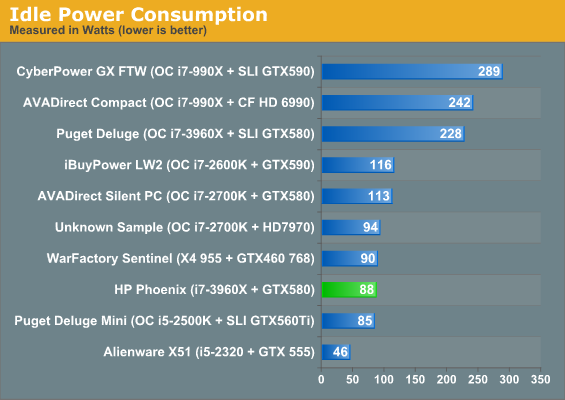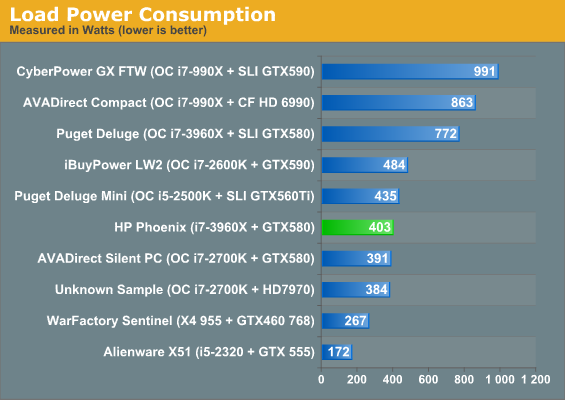HP Phoenix h9se: The Pavilion Goes Beyond Thunderdome
by Dustin Sklavos on February 29, 2012 12:00 AM ESTBuild, Heat, and Power Consumption
As mentioned before, HP has been able to leverage their size to produce a custom chassis that's reasonably small given the performance of the hardware contained within. What exactly does that mean? Let's assume the R&D and chassis design for a new case comes to around $1 million; for a boutique that might only sell 10K units (if that), it could mean at least $100 extra per system. A large OEM on the other hand that can move 100K units would only need to increase the cost of each unit by $10. Basically, economies of scale are very much in favor of the big OEMs (never mind the additional pricing benefits they enjoy for moving large volumes of CPUs, GPUs, etc.) Regardless of the size of company, though, it's the final product that matters. In the case of the Phoenix chassis, the result is a system with some modest thermal headroom and expandability to boot.
Externally the Phoenix looks like a slightly gussied-up Pavilion, but the aesthetic is pleasing. The side window glows from the red LED fan used on the liquid cooler's radiator, while the front has a series of red stripes that glow softly. I'm not a huge fan of glossy plastic, but here HP uses it primarily as an accent and it makes sense. The rest of the shell is a combination of gray plastic and black steel.
.jpg)
The internal design is about as cramped as you would expect, but HP includes disassembly instructions on the inside of the panel. Note the inverted design; the motherboard is affixed to the left side instead of the right, and the power supply is mounted at the top of the enclosure behind the optical drives. This arrangement paid off handsomely for SilverStone's Temjin TJ08-E enclosure and seems to be the right call for HP. The hard drive cage supports up to two 2.5" SSDs and a single 3.5" HDD.
While the motherboard has two PCIe x16 slots, there just isn't enough space or thermal headroom inside the Phoenix to handle any multi-GPU configurations, let alone power from the power supply. You could potentially use two slower GPUs, but that seems like a step backwards in overall performance potential and ease of use. Running a single GPU shouldn't be a problem, but it's something to keep in mind.

Thermally, HP's cooling system does an adequate job handling this configuration, but I'm not holding my breath for much in the way of overclocking headroom on the i7-3960X. I've generally been unimpressed by closed-loop CPU coolers, but it's still a better choice for shipping than a hefty tower cooler that can stress the motherboard if it's jostled too much. The GTX 580 posts numbers basically on par with what I've come to expect from this type of enclosure design; this is a chassis clearly intended for a specific thermal and power envelope and it meets those needs.


Power consumption for the Phoenix is, all told, pretty good. No one ever accused Sandy Bridge-E of being particularly frugal, but the system at least takes advantage of power-saving technologies on hand.


_thumb.jpg)
_thumb.jpg)
_thumb.jpg)
_thumb.jpg)
_thumb.jpg)
_thumb.jpg)








39 Comments
View All Comments
gdinero79 - Wednesday, February 29, 2012 - link
The last-generation SSD seems like an odd choice for a system like this.spencerp - Wednesday, February 29, 2012 - link
That sucks. I really like my Blackbird and was hoping to continue its lineage.cjs150 - Wednesday, February 29, 2012 - link
3G SSD?What were they thinking of
No overclocking
Limited GPU options
No crossfire/SLI (not that I am a fan of either)
What market is this aimed at?
And how noisy is it
dave1_nyc - Wednesday, February 29, 2012 - link
There are cases that I don't personally find attractive, but I understand why others do, and I'm sure the same. And if one likes this case, then one likes this case, and that's one's right.But I've been looking at the photos for the last 10 minutes, trying to figure out how one could like this case, assuming of course that you would remove all the stickers. And I don't get it.
This is too trivial to bother with, but I'd like to suggest a "who likes, who hates" survey - something that would help me suspend disbelief.
TrackSmart - Wednesday, February 29, 2012 - link
Very tactfully worded. Personally, I don't think many people would find this case more appealing than your average, cheap-looking $20 computer case. There are uglier cases, but this certainly isn't a looker.GuyIncognito_ - Wednesday, February 29, 2012 - link
> This is too trivial to bother with, but I'd like to suggest a "who likes, who hates" survey -> something that would help me suspend disbelief.
I vote <hate>.
Blibbax - Wednesday, February 29, 2012 - link
If anyone is thinking of buying one of these, please get in touch with me. I can match the performance and beat the looks with an OCd 2600K and a 7950 in a Casecom matx case, for a substantially lower price...bhima - Thursday, March 1, 2012 - link
For those that don't build their own machines there are other options than this proprietary HP. Just did a quick google, found Ironside Computers and built up a HAF 922 with an i7-2600k, SSD, regular HDD, 8GB ram, AMD 7970, Corsair Enthusiast 650w for about $1,900.Of course I would personally never purchase bleeding tech like the 7970 because the cost isn't worth its performance, but hell... for $600 cheaper than that HP you have a system with parts that aren't proprietary and the best single GPU on the market.
softdrinkviking - Thursday, March 1, 2012 - link
cases are too plastic and boring. not really bad looking exactly, but not so interesting either.i'd rather have an old grey 386 case with it's clean minimalist look.
also, HP uses a bunch of proprietary SD card readers and they put an a$$ load of metal brackets and header patch cables inside, the end result being that the inside is extremely cluttered and it's difficult to work on.
they are not upgrade friendly. :(